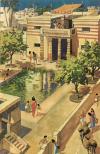An amphora is a jar with two vertical handles used in classical times for the storage and transportation of foodstuffs such as wine and olive oil. The name from the Greek amphiphoreus meaning ‘carried on both sides’, although the Greeks had adopted the design from the eastern Mediterranean, used by all the great trading nations from the Phoenicians to the Romans, the sturdy-walled amphora spread throughout the ancient world and they have become an important survivor in the archaeological record providing hints as to dates of sites, trade connections, and everyday diet.
Designs
Progressing from the large Bronze Age pithoi vessels, which the Minoans and Mycenaeans used for storage reasons, the amphora became the most common ancient pottery shape. However, the size and form had a great many variations. Amphorae could also be plain, when used for the transport of goods, or highly decorated, just as any other red-figure or black-figure pottery. Specific places, already noted for their pottery production, such as Corinth and Attica, along with famed wine-producing islands like Chios, Lesbos, and Samos all produced distinctive amphora types. So too did colonies in the Black Sea area and Magna Graecia, although some cities were happy enough to copy tried and tested designs. All amphorae were made in stages on the wheel with a period of drying between the addition of a new section.
The two basic types of amphora were the neck-amphora, which has the shoulder joining the neck at a sharp angle, and the belly amphora (or simply amphora) which curves continuously from neck to foot. Those vessels with broad mouths were known as either kadoi or stamnoi while the plain types for transport were referred to as amphoreus. Gradually the form of the vessel evolved to reflect its primary function as a carrier of wine and for ease of packing. The base foot became a spike and the vessel overall became taller and slimmer. In addition, during the Roman period, the contents of amphorae became easily identifiable from the shape of the vessel in question.
History
In the chalcolithic and middle ages amphorae spread around the ancient Mediterranean world, being used by the ancient Greeks and Romans as the principal means for transporting and storing grapes, olive oil, wine, oil, olives, grain, fish, and other commodities. They were produced on an industrial scale until approximately the 7th century AD. Wooden and skin containers seem to have replaced amphorae thereafter.
They influenced Chinese ceramics and other East Asian ceramic cultures, especially as a fancy shape for high-quality decorative ceramics, and continued to be produced there long after they had ceased to be used further west.
Various different types of amphorae were popular at different times:
On a neck amphora, the handles are attached to the neck, which is separated from the belly by an angular carination. There are two main types of neck amphorae, the Nolan amphora, named for its type site, Nola near Naples, and the Tyrrhenian amphora. There are also some rarer special types of neck amphora, distinguished by specific features, for example, the Pointed amphora, with a notably pointed toe, sometimes ending in a knob-like protrusion the Loutrophoros, used for storing water during ritual ceremonies, such as marriages and funerals.
Belly amphora, in contrast to the neck amphora, a belly amphora does not have a distinguished neck; instead, the belly reaches the mouth in a continuous curve. After the mid-5th century BC, this type was rarely produced. The pelike is a special type of belly amphora, with the belly placed lower, so that the widest point of the vessel is near its bottom. The pelike was introduced around the end of the 6th century BC.
Panathenaic prize amphora, another special type is the Panathenaic prize amphora, with black-figure decoration, produced exclusively as prize vessels for the Panathenaia and retaining the black-figure technique for centuries after the introduction of red-figure vase painting.
Miniature Roman Holy Land 1st–3rd century AD lead pilgrim’s votive amphora “Ampulla”. By the Roman period, practical amphorae were normally the only type produced.
The first type of Roman amphora, Dressel 1, appears in central Italy in the late 2nd century BC. This type had thick walls and a characteristic red fabric. It was very heavy, although also strong.
At the same time in southern Italy, the production of the cadii cumani type starts. These containers were mainly used for the transportation of fruit and were used until the middle imperial times. At the same time, in central Italy, the so-called Spello amphorae, small containers, were produced for the transportation of wine.
Functions
The average capacity for amphorae was 20-25 liters, although early versions were considerably larger. The general size became limited by the necessity for one or two persons to easily carry the vessel. Non-food contents transported in them included pitch, and some were used in tombs as containers for the ashes of the deceased. Another special type was the Panathenaic amphora which was a large vessel of around 36 liters decorated with black-figure designs. They were filled with olives and given as prizes in the Panathenaic Games, held every four years in Athens. Finally, miniature amphorae known as amphoriskoi or pelikai were used for storing perfume.
The Romans used amphorae in a similar manner to the Greeks but with the addition of such Roman staples as fish sauce (garum) and preserved fruits. For this reason, amphorae were sealed using clay or resin stoppers, some also had a ceramic lid when used to store dry goods. Very few lids have survived in proportion to amphorae but those that do commonly have a single knob handle sometimes made into the shape of a fruit. Finally, amphorae were used for completely unrelated purposes to their original design such as burial whole in marshy land to provide more solid foundations for buildings and walls or in roof domes as a means to provide additional support between courses.
All of this information has often been invaluable for archaeologists when attempting to date a site that contains amphorae, especially shipwrecks. Finally, the discovery of amphorae whose origin can be identified, and their quantities are helpful in determining the extent of trade in the ancient world. The Monte Testaccio in Rome is an artificial mound of pottery shards coming from some 53 million discarded amphorae; impressive testimony to the fact that the amphora was one of the most common and useful objects in antiquity.







Comments